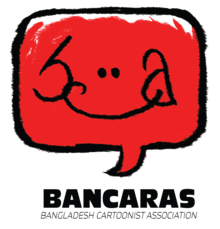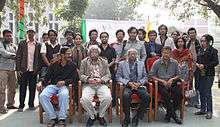Bangladesh Cartoonist Association
Bangladesh Cartoonist Association (BANCARAS) is an organization of the cartoonists of Bangladesh established in January 2011. The aim of the organization is to work as a common platform for countrywide cartoonists. BANCARAS keeps cartoonists connected by gathering with the work and thought of them. BANCARAS plans to arrange several cartoon exhibitions every year focusing different issues, as well as regular cartoon workshops.[1]
 | |
| Founded | January, 2011 |
|---|---|
| Headquarters | Dhaka, Bangladesh |
Key people | President: Zahid Hasan Benu |
| Website | www |
Platform
Nowadays cartoon is a very popular media in Bangladesh. But it was not so popular as it is now when it was just innovated in Bangladesh. First Bangladeshi cartoonist was Kazi Abul Kashem who started to draw cartoons in a magazine named "shawgat" in 1930s. In 1971s liberation war Quamrul Hassans cartoon "ei janowarder hotta korte hobe" influenced the freedom fighters deeply. In 1978, satire magazine Unmad published and got a high popularity among the people. In 80s and 90s editorial cartoons was getting popularity in the general people by the newspapers. After 2000 there increases a number of amateur cartoonist grew up from the young generation. Nowadays Bangladesh has a big number of newspapers where cartoon is a very popular section. To gather all the cartoonists on a common platform bring the BANCARAS to its birth.
History
BANCARAS established on January 2011 by organizing a cartoon exhibition, however its official work was started earlier by a gathering of some junior cartoonist at Unmad office presided by the Editor of Unmad Ahsan Habib (cartoonist) on June 2010.
The first exhibition of BANCARAS called “Dhaka Toons” was held inside the national press club between January 9 to January 1, 2011. The Dhaka Toons exhibition was mainly focused on the day to day issues we face living in Dhaka. Over 71 cartoons were featured highlighting different aspects and the common problems of Dhaka City. Dhaka Toons exhibition primarily featured cartoons that poked fun at the hassles of living in Dhaka; such as electricity, fuel and water crisis, crime, corruption and traffic jam. A total of 34 cartoonists participated in the event which was inaugurated by the famous Bangladeshi artist Qayyum Chowdhury. Veterans and amateurs alike were featured in this exhibition, from celebrated cartoonists like Shahriar Sharif, Ahsan Habib, Mehedi Haque, Shishir Bhattayacharjee, Tarikul Islam Shanto to new comers from various magazines and news papers. The exhibition featured cartoonists from Unmad, New Age, Shamakal and various other local news papers. The three day exhibition was met with a huge response by cartoonists, fan and the general curious masses.[2]
History of Bangladeshi cartoon
Cartooning in Bangladesh, or for that matter in the Indian subcontinent, cannot be precisely dated. When people call cartooning in the global context, they readily think about the Punch magazine which started coming out in 1841 although the term and its use dated back to the Middle Ages, being applied to preparatory drawing for a piece of art. In its modern senses, humorous illustrations in magazines and newspapers attested in the 19th century and comic strips attested in the early 20th century, cartooning came to this part of the world at the hands of the English people, with people of the subcontinent later picking it up. Cartoons, mostly political, began appearing in some English-owned newspapers such as Bengal Harkara and Indian Gazette in the 1850 but after the publication of the satirical magazine Punch, Fun and the Pall Mall Gazette, burgeoning publishers in Indian started to wake up to the trend, with the English-owned Delhi Sketch Book, lasting for seven years till the uprising of 1857. Partha Mitter is credited with publishing the first ‘Indian’ cartoon in Amrita Bazar Patrika in May 1872 as the periodical was India-owned and in an Indian language. Later two more periodicals of cartoons, Basantaka (1874–1875) and Panchananda (1878–1883) were published in Bengali. Some famous cartoonists of the subcontinent who worked for the last half of the past century were Abu Abraham, RK Laxman, who brought out The Illustrated Weekly of India, and Mario Miranda. When it comes to the land that now constitutes Bangladesh, Kazi Abul Quasem, who assumed the name of Dopeyaja in the cartooning world, first had his work published in the periodical Saugat in 1937. His works also got in print in Mohammadi, Bichitra, Daily Azad and some other magazines and periodicals; his work in the magazine Sainik (Soldier) captioned “Haraph Khedao Andolan” (Chase the Letters Movement) published in 1952 earned him a place in political cartooning here as the 1952 language movement later culminated into the independence of Bangladesh in 1971. During Bangladesh’s war for independence, ‘Patua’ Quamrul Hassan in a cartoon captioned ‘Annihilate these demons,’ one of the remarkable cartoons in Bangladesh’s history, portrayed General Yahya Khan as a demon. Another of his cartoons, captioned ‘The country is now in the grip of the most brazen-faced man,’ stirred the cartooning world. When the West Pakistan ruling class tried to impose Urdu as the official language on the people of East Pakistan in the late 1940s and the early 1950s, several artists such as Murtaza Basheer, Bijan Chwodhury, Aminul Islam, Quayyum Chowdhury Abdur Razzaq and Imdad Hossain did some posters in cartooning. Gradually quite a number of people started doing cartoons against the repression on the Bengalis by the West Pakistan rulers. Qayyum Chowdhury, who assumed the penname of Chouka, Kalam Mahmud as Titu, Rafiqun Nabi as Ranabi, who created the character of the benchmark street urchin called Tokai (gleaner) in the late 1970s, were the ones, to name a few. There were others like Azizur Rahman, who used to do cartoons under the penname of Aroop, Nazrul and Tofazzar Hossain, who had to embrace imprisonment for his work. Cartoonists who earned names in the 1970s and the 1980s are Asiful Huda, Syed Enayet Hossain and Shishir Bhattarcharya, who was noted for his cartooning against the regime of Hussain Muhammad Ershad, and Ahsan Habib, who along with his peers, brought out the most noted magazine Unmad, the Bengali for Mad, in May 1978; the magazine still runs to print every month although it had its prime time in the mid-1980s, with its focus being mainly on society and filmdom. Almost all daily newspapers worthy of the name now publishes cartoons on front pages; almost all Bengali newspapers run cartoon sections or bring out fun supplements which are full of cartoons.
Cartoon exhibition 2011
Bangladesh Cartoonist Association had arranged their 1st cartoon exhibition on 9–11 January 2011. At National Press Club compound a three-day exhibition was a big success with thousand of viewers. With this exhibition Bangladesh Cartoonist Association started its voyage ceremonially.[3]

Executive body
| Advisor | Rafiqun Nabi |
| Advisor | Ahsan Habib (cartoonist) |
| Advisor | Shishir Bhattacharjee |
| Advisor | Shahriar Khan |
| President | Zahid Hasan Benu |
| Vice-President | Shahriar Sharif |
| Secretary | Abu Hasan |
| Joint Secretary | Mehedi Haque |
| Joint Secretary | Kuddus Ahmed |
| Treasurer | Niaz Chowdhury Tuli |
| Organizing Secretary | Sadat Uddin Ahmed |
| Publicity Secretary | Zonayed Azim Chowdhury |
| Public Welfare Secretary | Nasreen Sultana Mitu |
| International Relation Secretary | Syed Rashad Imam (Tanmoy) |
| Office Secretary | Biplob Chakroborty |
References
- Hossain, Anika (14 January 2011). "Here's to a Bright and Funny Future". The Daily Star. Retrieved 2011-12-30.
- "Dhaka Toons: The First Exhibition by Bangladesh Cartoonists' Association". The Independent (Dhaka). 14 January 2011. Archived from the original on 2012-04-24. Retrieved 2011-12-30.
- http://www.thedailystar.net/magazine/2011/01/02/exhibition.htm